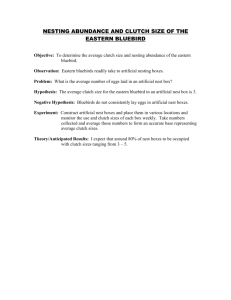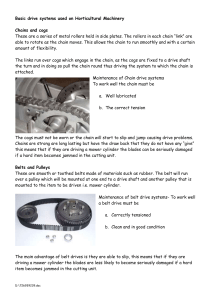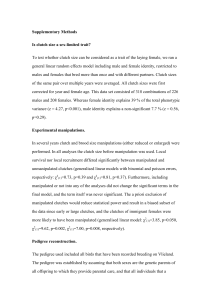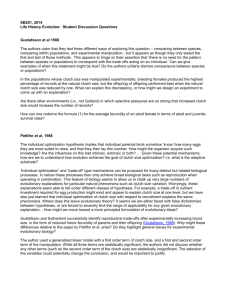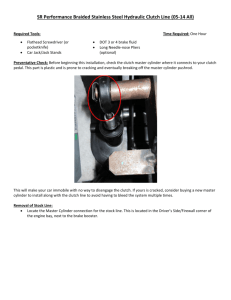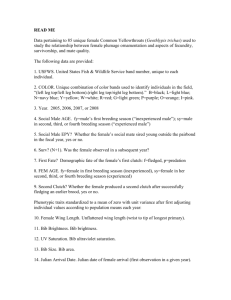The Clutch
advertisement
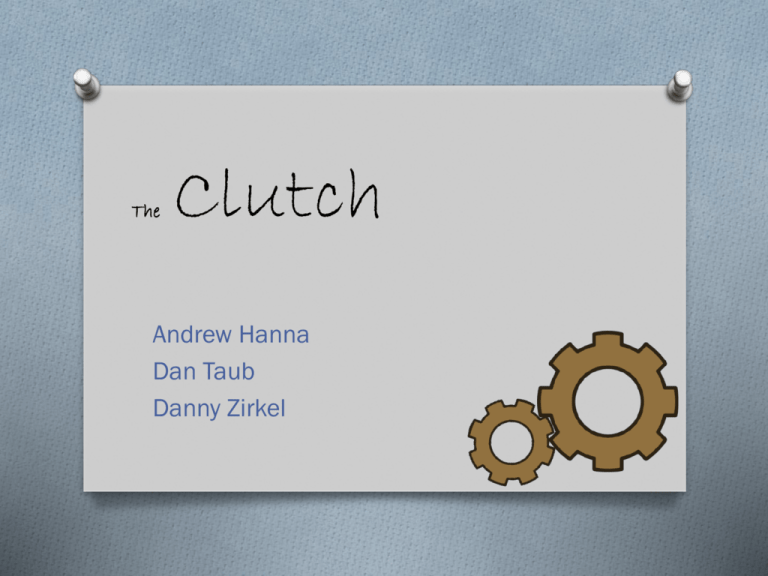
The Clutch Andrew Hanna Dan Taub Danny Zirkel Que es clutch? O Is it: O A: a firm grasp? O B: a handbag without handles? O C: A group of eggs fertilized at the same time, typically laid in a single session and (in birds) incubated together? O D: a device that enables two revolving shafts to be joined or disconnected as required, esp one that transmits the drive from the engine to the gearbox in a vehicle ? O E: all of the above? Exploded! Our Exploded Back Plate / Hub O Purpose: O Connected to main shaft; transfer rotational energy from clutch basket to transmission. Basket O Purpose: O House the clutch plates; connected to the primary chain. O Specs: O 48 teeth (engine sprocket has 18 teeth) O Gear ratio of 2.67/1 Friction Plate / Smooth Plates O Purpose: O Friction plate: connected to clutch basket O Smooth plate: connected to inner hub O When clutch engaged: both spin freely O When clutch not engaged: prevent slippage with surface friction between plates (allow transfer of energy between basket and hub) O Specs: O Plate thickness: 1/8 in O Plate diameter: 4.95 in Primary Chain O Purpose: O Transfer rotational energy from engine sprocket to clutch basket. O Specs: O 3/8 x 7/32 in O 62 links O Duplex Cups / Springs O Purpose: O Compress the clutch plates together when clutch is not engaged. O Specs: O Free length: 1.4 in O Compressed length (for testing): .77 in O Force applied during testing: 40lbs=177.93N O Spring constant: 761lbs/ft = 11,120.55 N/m Lever O Purpose: O Utilize mechanical advantage to lower the force needed on the handle. O Specs: O Distance from pivot to push rod: .25 in O Distance from push rod to applied force from cable: 2.5 in O Mechanical advantage: 5:1 Push Rod / Adjustment Screw O Purpose: O Transfer of mechanical energy from the lever to the pressure plate. O Specs: O Length: 7.01 in O Diameter: .156 in The Science Behind O How much force is required to depress the O O O O clutch? (Measurements based on ’58) Force to release clutch without any mechanical advantage: ~200lbs Divide by mechanical advantage of lever (5:1): ~40lbs Divide by mechanical advantage of clutch handle (2.5/.6 =4.2:1): ~9.5lbs (with no friction) Slippage O Symptoms: Engine revs but no corresponding acceleration. O How: Clutch slippage is when the clutch plates are slipping across each other, rather than engaging and transferring engine torque to the drive train. O Why: The cause can be a poorly adjusted clutch, or worn springs, or worn plates. O Our clutch slips at between 6 and 9 ft lbs with well-compressed springs. ’58: The Devil’s Dance O Clutch was heavy, noisy O During testing, clutch cable “snapped” O Solution 1: We used emory paper to smooth out the teeth on the driven clutch plates, then buttoned up and attached new cable O Consequences: “Oh, well that’s just awful.” ‘58 (continued) O Solution 2: We lubed cable to stop noise; tightened adjustment screw for better pushrod connection O Consequences: “…still worse than it’s ever been.” O Solution 3: Run cable along a straighter path (reduce friction) O Consequences: “The best this clutch has ever felt!” ‘59: Re-assembly O Original parts: O O O O O Back plate / hub Lever Pushrod Springs/cups/screws Adjustment screws O New parts: O O O O Basket Friction plates Driven plates Cable Re-assembly Dis wus the best presentA-tion ah eva did see! Clutch Photoshoot ‘13
